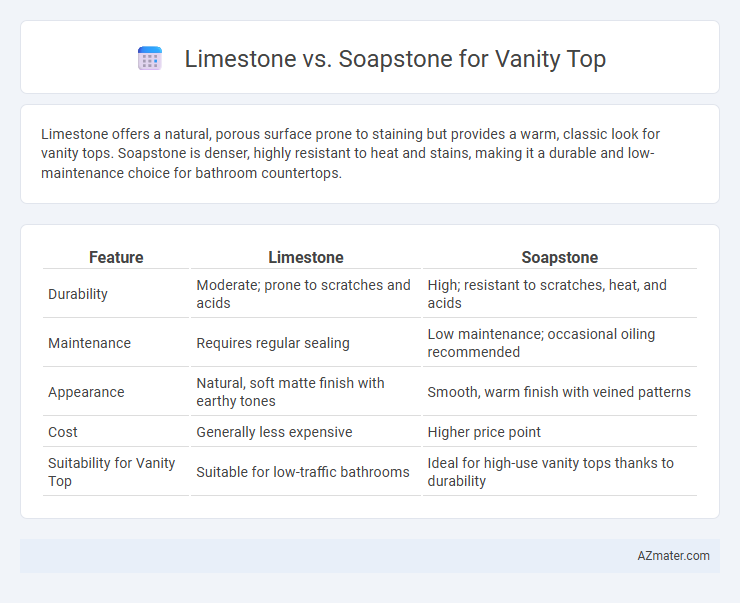Limestone offers a natural, porous surface prone to staining but provides a warm, classic look for vanity tops. Soapstone is denser, highly resistant to heat and stains, making it a durable and low-maintenance choice for bathroom countertops.
Table of Comparison
| Feature | Limestone | Soapstone |
|---|---|---|
| Durability | Moderate; prone to scratches and acids | High; resistant to scratches, heat, and acids |
| Maintenance | Requires regular sealing | Low maintenance; occasional oiling recommended |
| Appearance | Natural, soft matte finish with earthy tones | Smooth, warm finish with veined patterns |
| Cost | Generally less expensive | Higher price point |
| Suitability for Vanity Top | Suitable for low-traffic bathrooms | Ideal for high-use vanity tops thanks to durability |
Introduction to Vanity Top Materials
Limestone and soapstone are popular choices for vanity tops due to their natural stone characteristics and durability. Limestone offers a warm, porous surface with subtle texture, suitable for classic and rustic bathroom designs, while soapstone provides a non-porous, dense material with excellent resistance to stains and heat, ideal for modern and functional spaces. Both materials require different maintenance approaches, with soapstone needing occasional oiling to enhance its natural patina and limestone benefiting from regular sealing to prevent water absorption and etching.
Overview of Limestone and Soapstone
Limestone is a sedimentary rock composed mainly of calcite, valued for its natural, warm appearance and relative softness, making it prone to scratching and etching on vanity tops. Soapstone, a metamorphic rock rich in talc, offers a smooth, non-porous surface that resists heat, stains, and bacteria, making it highly durable and ideal for bathroom vanity tops. Both materials provide unique aesthetic appeal, with limestone showcasing earthy tones and subtle patterns, while soapstone features darker, uniform colors with a silky texture.
Aesthetic Differences: Limestone vs Soapstone
Limestone vanity tops offer a warm, natural appearance with subtle fossilized patterns and a light, creamy color palette that enhances traditional and rustic bathroom designs. Soapstone, in contrast, presents a smooth, matte finish with darker hues ranging from deep gray to black, providing a sleek, contemporary aesthetic ideal for modern or industrial bathrooms. The unique veining in soapstone adds visual depth, while limestone's softer texture and color variation create a more organic, earthy ambiance.
Durability and Longevity Comparison
Limestone and soapstone differ significantly in durability and longevity for vanity tops. Limestone is softer and more porous, making it prone to scratches, stains, and acid damage, requiring regular sealing to maintain its appearance. Soapstone offers superior durability with its dense, non-porous surface that resists heat, stains, and scratches, ensuring a longer-lasting, low-maintenance vanity top ideal for high-use bathrooms.
Maintenance Requirements for Each Material
Limestone vanity tops require regular sealing to prevent staining and are sensitive to acidic cleaners, making routine gentle cleaning with pH-neutral products essential. Soapstone, known for its high density and resistance to stains and acids, demands minimal maintenance but benefits from periodic applications of mineral oil to enhance its natural luster and darken its surface. Both materials offer durability; however, soapstone's lower porosity makes it more resilient against moisture and easier to maintain over time.
Resistance to Stains and Chemicals
Limestone is more porous than soapstone, making it more susceptible to stains and etching from acidic substances commonly encountered in bathroom environments. Soapstone offers superior resistance to both stains and chemicals due to its dense, non-porous composition and natural talc content, which makes it highly durable against common bathroom products. For vanity tops, soapstone requires less maintenance and provides better longevity in resisting discoloration and chemical damage compared to limestone.
Cost Analysis: Limestone vs Soapstone
Limestone vanity tops generally cost between $50 to $75 per square foot, offering a budget-friendly option with moderate durability and natural aesthetic appeal. Soapstone ranges from $70 to $120 per square foot, reflecting its superior resistance to heat, stains, and scratches, which justifies the higher upfront investment. Evaluating long-term maintenance and durability, soapstone often provides better value despite its higher initial cost due to lower repair and replacement expenses.
Environmental Impact and Sustainability
Limestone for vanity tops is a natural sedimentary rock with a moderate environmental impact, as quarrying can disrupt ecosystems and consume significant energy. Soapstone, primarily composed of talc and magnesium silicate, is often considered more sustainable due to its durability and lower porosity, reducing the need for frequent replacement or sealing. Both materials can be sourced responsibly, but soapstone's longevity and resistance to chemicals contribute to a smaller overall carbon footprint in bathroom applications.
Best Applications for Each Material
Limestone offers a porous, natural aesthetic ideal for low-traffic bathroom vanity tops due to its susceptibility to staining and etching, making it best suited for powder rooms or guest bathrooms. Soapstone provides exceptional durability and resistance to heat, stains, and acids, making it a superior choice for high-use vanity tops in busy family bathrooms or kitchens. Its non-porous surface requires minimal maintenance while offering a smooth, matte finish that withstands daily wear and moisture exposure.
Conclusion: Choosing the Right Vanity Top
Limestone offers a natural, matte finish with warm tones that complement classic and rustic bathroom designs, but it requires regular sealing due to its porous nature. Soapstone provides superior durability, resistance to heat and stains, and a smooth, subtly variegated surface ideal for contemporary or minimalist styles. Selecting between limestone and soapstone depends on prioritizing aesthetic appeal versus maintenance needs, with soapstone favored for longevity and limestone chosen for its unique texture and color variations.

Infographic: Limestone vs Soapstone for Vanity Top
 azmater.com
azmater.com